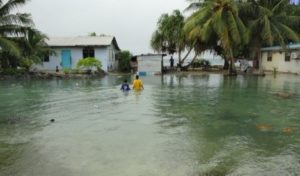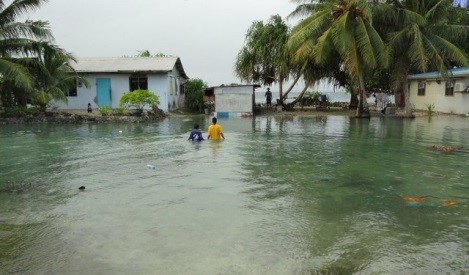
Indigenous people living on the Marshall Islands have a grim history and are facing a potentially grim future. The Marshallese peoples were displaced due to nuclear testing in the past and are confronting the threat of relocation due to climate change in the future. Sitting mere feet above sea level, the Marshall Islands are a group of 24 atolls with just over 1,500 islands, and a population near 70,000 people. The islands are at risk of complete submersion due to rising sea levels as a direct result of climate change. The United Nations Intergovernmental Panel on Climate Change estimates they will see a three foot rise in the sea level by 2100, while other estimates are as high as six feet. The rapid effect of climate change already occurring on the islands along with the risk of losing their homeland has propelled the government into immediate action.
The Marshallese are the first peoples from a developing nation to go beyond the mere slowing of carbon emissions straight into a commitment to completely cut them altogether. They plan to cut emissions by nearly half by 2030, and to zero by the year 2050. They intend to accomplish this through the use of sustainable technology by relying entirely on solar energy. The plan is to completely solarize the islands and build their economy through deals with large companies, using ocean thermal energy conversion (OTEC). Hydrogen is produced through solar energy. By completely replacing fossil fuels, the Marshall Islanders are leading the way in the worldwide objective to slow global warming.
As the Marshallese get to work, the rest of the world is watching more than following their strategies. Part of the problem many nations face in reaching these goals is the result of their much larger populations. The Marshall Islands have fewer people to provide with energy, making it easier for them to accomplish these objectives in a shorter length of time. In addition, the Marshall Islanders do not release anywhere near the amount of carbons as the developed nations.
While Kiribati has already purchased land in Fiji in case they are forced to relocate, President Loeak plans to tough it out and fight to save their homeland. Because natural disasters are becoming more frequent on the islands, they are also making plans to expand the land area that is being swallowed by the sea as well as creating long-term disaster plans.
The Marshall Islands are not the only nation threatened by climate change; the entire world will suffer if we do not reduce carbon emissions and slow global warming. The Marshall Islands cannot turn this around alone. As such, other nations are feeling the pressure to match their goals. The push to do more to reverse climate change is increasing because the human rights of the indigenous peoples on the islands are at stake. The Islanders are once again at risk of losing their lands, lives, and culture if the rest of the world does not quickly do their part. As the largest emitters of carbons, it is up to the developed nations to make serious efforts to reverse the damage we are creating. At base, our continued contribution to the environmental disaster faced by the Marshallese people is not much different than the nuclear testing that resulted in the islanders losing their homelands in the past.
Bernadette Shetrone is a 3L at the University of Denver Sturm College of Law and a Staff Editor on the Denver Journal of International Law and Policy.


